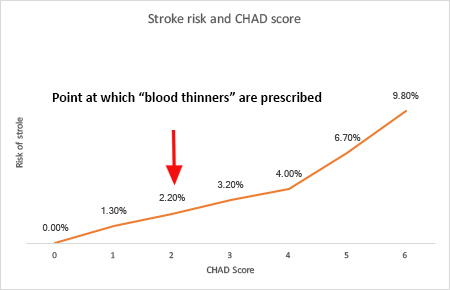Atrial fibrillation is the most common irregular heartbeat, affecting 2.7 million Americans. Up to 15% of patients with atrial fibrillation can experience a debilitating stroke, so prevention is important. Unfortunately, prevention comes with its own risks so physicians have developed “risk calculators” to determine who should be treated. A paper in Journal of American College of Cardiology suggests that the current scheme can be improved – and without any more significant effort or expense.
Atrial fibrillation
The heart has four chambers, the two upper atria, and the two lower ventricles. The contraction of these chambers, the actual pumping of the blood, is initiated and coordinated by the heart’s electrical system. The signal begins in an area of the heart called the sinus node. It travels through the atria, causing them to contract and pump blood into the ventricles. The signal continues through the area connecting the upper and lower chambers, the AV node, where it causes the ventricles to contract and push the blood out into your lungs and arteries. In atrial fibrillation, the signal from the sinus node is chaotic and disorganized resulting in the atria fluttering rather than contracting and the signal reaching the AV node is more frequent causing the ventricles to contract more, an increased heart rate. These abnormalities of the heart’s electrical system results in heart rates of 100-175 beats per minute and the spacing between beats is irregular.
Atrial fibrillation can result in the heart muscle weakening from the increased heart rate, a condition termed congestive heart failure; or the fluttering of the atria, those upper chambers, may allow blood to pool and form a clot. The clot can travel from your heart to your brain and cause a stroke.
“CHAD” score

Physicians have developed a risk calculator to determine who is more likely to have a stroke from their atrial fibrillation. It considers age, gender and the presence of other medical problems [1]. Patients with an increased score are more likely to have a stroke and physicians try to protect these patients by prescribing blood thinners. Blood thinners are actual a misnomer; the drugs are anticoagulants, they prevent blood from clotting. The current approach in using CHAD scoring is to evaluate the patient at the onset of atrial fibrillation and base therapy on that moment in time – one and done. Researchers in Taiwan believe that approach is flawed.
The Study
The authors accessed administrative health records and identified 31,000 who had atrial fibrillation and no other problems (co-morbidities) – so their CHAD score was based solely on their age and gender. They followed them over time, at least retrospectively, and identified 4,100 who had strokes. The initial CHAD score was predictive, but recalculating the score as the patient’s condition changed was more predictive.
- The mean age of the patients ranged from 64 to 67, with a baseline CHAD score of 1.29 (Age and female gender provide 1 point each)
- CHAD scores rose by 1.02 points over the time course of the records for about 60% of the patients as they developed new problems.
- 37% developed high blood pressure, 27% congestive heart failure, 13% diabetes, and 6% had a new heart attack or other sign of vascular disease. The remaining increases in CHAD scores was due to age (the scoring treats those between 65 and 74 differently than those 75 or older)
- 50% of patients had only one new risk factor, 36% had two, 13% had three or more comorbidities
The researchers found that the stroke risk was not a static, one and done, situation; it increased over time as the clinical situation changed. More importantly, they noted that the faster the clinical picture got worse, the higher the risk. And that much of that risk was in the first three months after the changes were noted.
The Takeaway
Treating patients with atrial fibrillation with blood thinners to prevent strokes is not without significant problems, particularly an increased risk of bleeding and the necessity to have your blood checked (and that means needles and a trip to the lab) monthly or more often. [2] CHAD scores help identify those that need this treatment from those who would do just as well without. But over time, this latter group, which initially were without risk develop new problems and recalculating their CHAD score could reduce their risk of stroke by initiating treatment. Risk changes and so should risk scoring. The one and done approach is important in research; it helps keep groups similar so we can study disease progression as these authors did. But it has a more limited role in clinical care, re-stratifying risk when conditions change is easy, and the authors have demonstrated that it can be helpful for our patients.
[1] 1 point each is given for being between 65 and 74, female, having congestive heart failure, high blood pressure, diabetes or prior heart attack or other vascular diseases. 2 points are given for age 75 or more or a prior stroke or transient ischemic attack. Patients with scores of greater than two are often treated with blood thinners.
[2] Warfarin (Coumadin) is the classic anticoagulant and requires changing doses and careful observation through laboratory tests. The novel oral anticoagulants, like the heavily advertised Eliquis, have a stable dose without the need for laboratory tests and may have fewer bleeding problems.
Source: Relationship of Aging and Incident Comorbidities to Stroke Risk in Patients With Atrial Fibrillation Journal of American College of Cardiology DOI: 10.1016/j.jacc.2017.10.085




